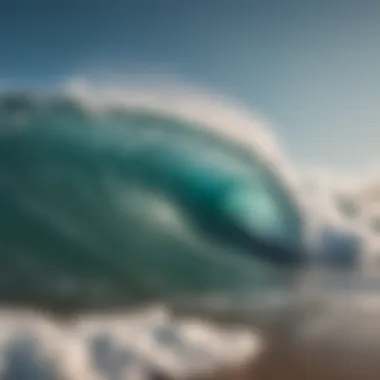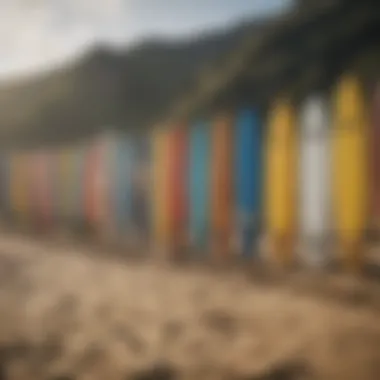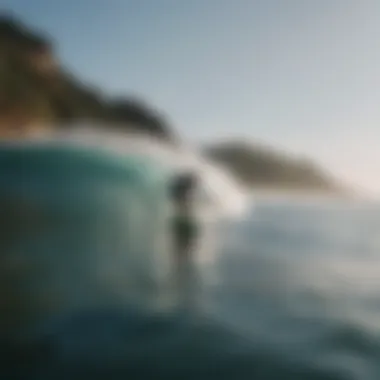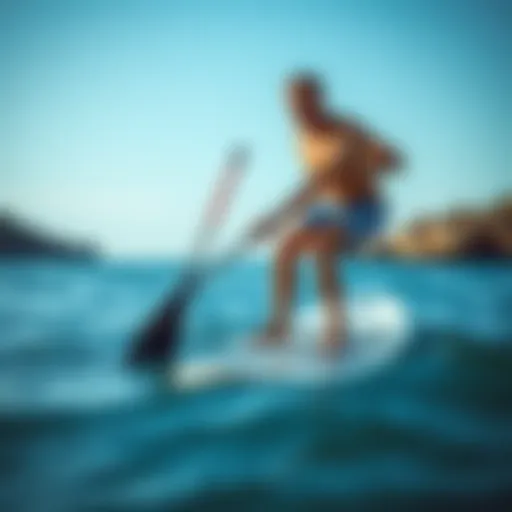Exploring Surf Culture: Techniques and Community


Intro
Surfing, in many ways, transcends mere sport. It’s a lifestyle woven into the very fabric of coastal communities across the globe. From the early morning whispers of the ocean to the thrilling ride on a wave, the entire experience is nothing short of a dance with nature. While the thrill of catching waves is a significant part of surf culture, countless elements contribute to what it means to be a surfer today.
This exploration will travel through the world of surf culture, diving deep into gear, techniques, skills, and even the ecological impact each surfer has on our oceans. Through the interplay of personal stories and expert advice, we aim to craft an understanding that resonates with everyone from the sun-soaked novice to the veteran surfer who lives for that perfect swell.
Built on community and connection, surf culture encompasses a dedication to the oceans, embracing both the challenges and joys that come with riding waves. As we kick off this journey, let’s take a closer look at the heart of the surfing experience—the gear that keeps us afloat, and the skills that bring each ride to life.
Surf Gear and Equipment
Latest Surfboard Technologies
In the ever-evolving landscape of surfboards, innovation is the name of the game. Surfboard technology has come a long way from traditional wooden boards to modern-day shapes designed for performance. Materials have shifted as well; fiberglass and epoxy are now common, offering enhanced durability and buoyancy. Consider a board like the Firewire EQ, which integrates advanced environmental practices in its production, showcasing how technology and sustainability can go hand in hand.
With the growing popularity of eco-friendly options, brands like Greenlight are offering surfboards made from recyclable materials, helping to diminish the industry's environmental footprint. These boards maintain performance without compromising the planet.
Essential Accessories for Surfers
Accessories are vital to a surfer’s arsenal. Key items include:
- Wetsuits: Essential for warmth in chilly waters, modern wetsuits are designed with various thicknesses and materials to suit different climates.
- Leashes: Connecting you to your board, a sturdy leash is crucial. Opt for a brand like Creatures of Leisure for durability.
- Wax: The right grip on your board is paramount. Simple as it sounds, using the wrong wax could mean a slippery ride and a quick dip.
- Beach Bag: To cart your gear around, a reliable water-resistant beach bag like those from Patagonia can make a difference.
While gear can be a personal choice, it influences a surfer's experience significantly. Selecting the right equipment not only boosts performance but also enhances safety.
Techniques and Skills
Wave Riding Strategies
Riding a wave is an art that requires precision and timing. Understanding the mechanics of waves—how they break, peak, and roll—provides essential context when choosing your approach. A simple strategy includes:
- Positioning: Sit in the right spot to catch the wave at its peak.
- Paddle with intent: Timing your paddling to match the wave’s approach is crucial. The more you understand wave patterns, the better your timing will become.
- Pop-up mechanics: This movement is vital. A quick transition from lying down to standing will determine your ride's success. Practice makes perfect, and don't shy away from using foam boards when starting.
Safety and Surf Etiquette
Being a part of the surfing community also means adhering to certain unwritten rules. Surf etiquette ensures everyone enjoys the waves:
- Always respect the surfer already on the wave.
- Communicate with gestures to avoid collisions.
- Keep a safe distance when paddling back to your spot.
Surfer safety isn't only about being courteous; understanding rip currents and tides is imperative. Staying informed and aware not just safeguards your own experience but also contributes to a safer and more enjoyable environment for everyone in the water.
"In surfing, being part of something bigger than oneself enriches the experience—it's about respect for the ocean and its riders, making each wave a shared journey."
Ultimately, knowledge of gear, techniques, and etiquette forms the backbone of true surf culture. As we embrace the waves, it’s essential to acknowledge the community we’re part of and its responsibility toward the environment that sustains us.
The Essence of Surfboarding
Surfboarding is more than just a sport; it encapsulates a lifestyle, a community, and a deep connection to nature. It represents freedom, adventure, and the pursuit of mastering the waves. For many, riding the surf becomes an essential part of their identity, intertwining with their social circles, travel experiences, and environmental awareness. Understanding the essence of surfboarding is crucial, as it sheds light on the motivations behind this exhilarating pursuit.
The intricate relationship between surfers and the ocean highlights why surfboarding holds such significance in coastal cultures around the world. Each surf session is not just about catching waves; it's also an opportunity for introspection, camaraderie, and the pursuit of a visceral thrill that can't easily be replicated elsewhere.
History and Evolution
Surfing has a rich history that dates back centuries, originating in ancient Polynesian culture. Initially, surfboards were simple wooden planks crafted from local trees. As the sport evolved, it grew in popularity and sophistication, embracing modern materials and techniques. In the early 20th century, surfing made its way to California, driven by exciting figures like Duke Kahanamoku, who showcased the sport's allure and athleticism.
Over time, surf culture blossomed, fostering a unique community grounded in shared experiences and respect for the ocean. The sport went through waves of transformation, incorporating new styles, techniques, and even competitive formats. Each evolution represents not just a change in method but a reflection of societal values, creativity, and the perennial human quest for adventure.
The Cultural Significance of Surfing
Surfing is steeped in culture, serving as more than just a pastime. It embodies a lifestyle centered around coastal living, with values that resonate across generations. Surfers often form tight-knit communities, supporting one another both in and out of the water. This vigorous sense of belonging fosters lifelong friendships and shared experiences, shaping individual identities and collective narratives.
From iconic films like The Endless Summer to international competitions such as the World Surf League, surfing has positioned itself as a cultural phenomenon. It inspires artistic expressions across various media, from photography to music, and raises awareness of environmental issues affecting oceanic ecosystems. Surfers are frequently at the forefront of movements advocating for ocean conservation, recognizing that their passion is intimately tied to the health of the waters they cherish.
Surfing is not just a sport. It's an art of living, a language of connection, and a beacon for environmental advocacy.
Ultimately, the essence of surfboarding lies in its ability to unite people, foster creativity, and promote a profound respect for the natural world. As we navigate its depths, we gain not only technical prowess but also a holistic appreciation for the life lessons that surf culture imparts.


Gear Selection for Surfers
The world of surfing isn't just about catching waves; it's also about the gear you'll ride those waves with. Choosing the right equipment can make all the difference in enhancing your performance and overall experience in the water. The right surfboard, accessories, and safety gear not only contribute to your own surfing skills but also ensure you ride with confidence and style. This section examines key components of surf gear, focusing on surfboard types, essential accessories, and the sometimes-overlooked, yet crucial elements that tie into your surf success.
Understanding Different Surfboard Types
On the surface, a surfboard might seem like just a piece of foam and fiberglass, but pick the wrong one, and you could be fighting the waves instead of dancing with them. Surfboards come in various shapes and sizes, each tailored to different riding styles and conditions. Starting with longboards, these boards are the gentle giants of the surf world. Perfect for beginners or those enjoying a laid-back cruise, their stability and buoyancy make hanging ten a breeze. On the other hand, shortboards offer agility and responsiveness, prized by those wanting to perform tricks and ride more challenging waves. Then there's a broad spectrum of hybrids and fishes, each suited for specific conditions and audience preferences.
When selecting a surfboard, factors like your skill level, the surf spots you frequent, and the type of riding you aspire to do come into play. Understanding these different designs isn’t just about looks; it’s about optimizing your time in the water.
Essential Surfing Accessories
Accessories may seem like an afterthought, but in reality, they play a key role in your surfing adventure.
Wetsuits
When it comes to wetsuits, no one ever wishes they had less warmth, especially as temperatures drop. A good wetsuit can be a game changer in chilly waters. The main goal of a wetsuit is to keep you warm while you paddle and ride. The key characteristic of wetsuits lies in their material – usually neoprene – which insulates heat while allowing some water to enter, creating a warm layer against your skin.
The thickness of the suit is essential; generally, a thicker wetsuit is suited for colder waters. Especially beneficial for surfers keen on year-round sessions, a good wetsuit enhances comfort without sacrificing flexibility. However, they can feel restrictive at first if you’re used to an easy-breezy shorty.
Leashes
Now, leashes might not catch the eye like a flashy board, but don’t underestimate them. A leash keeps your board tethered to you, ensuring it doesn't wander off after a wipeout. This crucial piece of gear helps maintain safety for both you and fellow surfers by preventing runaway boards from becoming projectiles in the water.
The essential feature here? The cord's strength and thickness. Beginners might lean toward thicker leashes for added security, while more experienced surfers often opt for thinner ones that create less drag. Regardless, the right leash can save you a lot of hassle.
Wax
Wax may not look like much, but it makes a world of difference when you’re riding those waves. Its primary job is to provide traction, making sure your feet don’t slip off the board when the momentum picks up. The key here is to apply the wax appropriately – a simple grid application can give you better grip.
Different waxes suit varying water temperatures, with warm water types being softer and cold water wax being harder. It's all about maximizing control in the water. Just bear in mind, over-waxing can lead to a slippery mess, so moderation is key.
Choosing the Right Fins
Fins might be the unsung heroes of your surf setup. Not just a standard feature; they are strategic components that affect how your board handles on the waves. The right fin setup can change your turning radius, speed, and overall performance.
When you’re choosing fins, consider your surfing style. Softer fins are great for smoother, forgiving curves, while stiffer fins offer more grip for sharper turns and performance in powerful surf. Discovering the right fin configuration—single, twin, thruster, or quad—will lead you closer to mastering the surf dance in your desired conditions.
"The right gear doesn’t replace skill but enhances your potential to turn waves into opportunities for joyful expression and adventure."
Understanding gear selection is a critical stepping stone for any surfer, whether novice or pro. The intricacies of these choices can elevate your surfing experience, creating memories that linger far beyond the foam of your last ride.
Embrace these options as not just accessories, but essential ingredients that weave into the greater narrative of your journey through surf culture—making each session worthwhile and deeply fulfilling.
Mastering Surf Techniques
Mastering surf techniques is not just about hopping on a board and catching waves; it plays a pivotal role in enhancing the overall surfing experience. For both beginners and seasoned surfers, refining skills can lead to greater enjoyment, increased safety, and ultimately, a more profound connection to the ocean. Techniques moderate between simple turns and advanced aerial maneuvers, and each stage offers its own challenges and rewards. The benefits range from improved performance to the ability to read waves correctly and respond accordingly to the ever-changing conditions of the sea.
Fundamental Skills for Beginners
For the novice, the journey begins with a foundation of fundamental skills. These include paddling, popping up, and balancing on the board. Each of these skills is essential for getting up and riding a wave. Starting with paddling, it’s important to develop a good rhythm. Paddling is not just about moving your arms; it's about positioning your body correctly to maintain stability while generating enough speed to catch that wave.
Learning to pop up is the next major milestone. It’s the moment when a surfer transforms from lying on the board to standing up. It might feel like learning to ride a bike; it just takes practice. Finally, balancing is crucial, as it's the key to staying upright and maneuvering successfully. With attention to these basics, a beginner can make strides towards a smoother surfing experience.
Advanced Maneuvers for Experienced Surfers
Once a surfer is comfortable with the basics, it's time to explore advanced maneuvers. Tricks such as cutbacks, floaters, and aerials open up exciting possibilities on the waves. Cutbacks involve turning back towards the breaking part of the wave, allowing for increased speed and control. Floaters require the surfer to ride the top of the wave's lip, a delicate balance of timing and execution that establishes a thrilling ride. Additionally, aerials push the limits of gravity and should only be attempted by those confident in their skills. Each of these techniques adds layers of complexity to the surf experience, allowing for personal expression and advancement in performance.
The Importance of Wave Knowledge
Without a doubt, understanding the dynamics of waves is crucial for any surfer. Whether a beginner or an expert, this comprehension transforms a surfer's approach and greatly enhances their performance. Knowing how to read the waves will dictate when to paddle and catch them. There are a few vital elements that contribute to mastering wave knowledge.
Reading Waves
Reading waves goes beyond just seeing the crest; it involves understanding how waves form and break. Each wave tells a story of the ocean's movement. Surfers should observe the swell patterns, as this helps determine the type of ride they'll get. A common trait is that bigger waves often produce a more exhilarating experience, but they require respect and skill to ride safely.
The benefits of honing this skill include more successful wave catches and a heightened ability to enjoy the energy of the ocean. By interpreting the waves correctly, surfers can position themselves more strategically, maximizing both safety and thrill. It’s one of those things that makes a real difference out there.


Understanding Tides
Understanding tides is equally important as it influences wave conditions significantly. Tides affect the height and power of waves, which in turn changes the surf experience. The key characteristic here is the relationship between the tide cycle and wave quality. Surfers should know whether the tide is coming in or going out, as each state can create vastly different surf conditions.
One unique factor about tides is that they are predictable. By keeping track of local tide charts, surfers can plan their outings to coincide with favorable conditions. A disadvantage is that not all beaches work the same way with tides, which means surfers must do their research and observe firsthand. Nonetheless, the ability to read tides gives surfers a competitive edge, allowing them to chase the best breaks effectively.
"Surfing is not a hobby, it’s a way of life—and mastering these techniques brings you closer to that life rather than just scratching the surface."
By grasping these fundamental principles of technique, wave reading, and tide understanding, surfers can cultivate their skills. Eventually, they'll achieve a mastery that connects them deeply with the surf culture and the natural environment, empowering them to ride not just the waves, but the currents of the ocean’s rhythm.
Health and Fitness for Surfers
Surfing, beyond being a thrilling ride on waves, demands a strength and stamina that few people realize until they try it firsthand. The sport requires a level of physicality, agility, and mental alertness that can only be achieved through a dedicated focus on health and fitness. As surfers, honing one's physical abilities not only improves performance but also helps in preventing injuries, enabling longer and more enjoyable sessions in the ocean.
Physical Training Regimens
Building a solid fitness base is essential for any surfer. Various physical training regimens can enhance core strength, flexibility, and cardiovascular fitness. Below are the key components to incorporate in a surfer’s training routine:
- Core Strength Exercises: A strong core improves balance on the board and helps with paddling. Exercises like planks, Russian twists, and medicine ball throws are effective.
- Flexibility Training: Stretching and yoga aren’t just for relaxation; they increase flexibility, crucial for maneuvering on the surfboard. They help prevent muscle strains and improve range of motion.
- Endurance Cardio: Surfing often entails long hours of paddling and duck diving. Incorporating endurance training through running, cycling, or swimming can greatly benefit a surfer's stamina.
- Strength Training: Focusing on leg strength through squats and lunges, alongside upper body workouts with push-ups and pull-ups, builds the essential muscles needed for paddling and popping up on the board.
Ultimately, a well-rounded physical training regimen keeps surfers fit and ready to hit the waves.
Nutrition for Optimal Performance
“What you put in is what you get out,” is an old saying that rings particularly true for surfers. A keen focus on nutrition can significantly enhance a surfer’s performance both out on the water and in training sessions. Key considerations include:
- Balanced Diet: Emphasizing whole foods like fruits, vegetables, lean proteins, and complex carbohydrates can provide steady energy and recovery. Think of your plate as an opportunity to replenish nutrients lost during surfing.
- Hydration: Staying hydrated is critical, especially in the sun and saltwater. Drinking enough water before, during, and after surfing helps maintain energy levels and focus.
- Pre- and Post-Workout Snacks: Eating a small snack that mixes carbs and protein prior to surfing can fuel your performance. Similarly, a post-surf meal rich in protein helps with recovery and muscle repair.
- Supplements: Some surfers find benefit in supplements like omega-3 fatty acids for joint health, or protein powders to ensure they meet their dietary protein needs.
"Investing in your body’s fuel not only powers your performance but protects it from the wear and tear of the ocean."
Taking the time to cultivate health and fitness routines is not just beneficial; it’s imperative for anyone looking to surf effectively and avoid the dreaded burnout or injury. Such a commitment prepares surfers to tear it up on the waves while cherishing the health that sustains them.”
Maintenance and Care for Surf Equipment
Taking care of your surf equipment is crucial. It’s not just about keeping your gear looking spick and span; proper maintenance can significantly extend the lifespan and enhance the performance of your surfboards and accessories. When you invest in surfboards, wetsuits, and fins, neglecting their upkeep can lead to costly replacements and a diminished riding experience. This section dives into the essential practices that keep your gear in top condition, ensuring that you can ride the waves smoothly and safely.
Cleaning Techniques for Surfboards
After battling the waves, the last thing you want is your surfboard to end up looking beat up. A regular cleaning routine is vital. Here are some effective methods:
- Fresh Water Rinse: After every session, rinse your surfboard with fresh water. Saltwater can corrode and damage materials over time, so it’s best to wash that away after each use.
- Soft Cloth: Use a microfiber cloth to wipe down the surface. This helps remove sand, dirt, and any residues that might cause scratches on the board. Always be gentle; you want the board to stay in mint condition.
- Specialty Cleaners: For stubborn grime or stains, consider using specialized surfboard cleaning products. They target wax and dirt without damaging your board's finish. A little goes a long way, and following the manufacturer’s instructions can save a lot of headache.
- Avoid Harsh Chemicals: It’s tempting to grab those powerful cleaners around the house, but using harsh chemicals can strip away the finish on your board. Stay clear of anything that’s not designed for surfboards.
"A clean board means a happy ride. Treat your gear with respect, and it will pay you back in joyful rides."
Storage Practices to Extend Lifespan
Proper storage of your surf equipment is as important as cleaning it. When not in use, how you store your board, wetsuit, and other accessories can significantly impact their longevity. Consider the following storage tips:
- Keep Away from Direct Sunlight: UV rays can cause significant deterioration over time. Store your surfboard in a cool, dry place away from direct sunlight. If you have to keep it outside, use a board bag with UV protection.
- Use a Board Bag: Invest in a good quality board bag. It provides protection against dings, scrapes, and UV exposure. A padded bag is worth its weight in gold, especially if you travel with your board.
- Vertical Storage: If space allows, store your boards vertically or on a rack. Sitting them down on their fins can warp them or wear out their edges over time. Keeping them off the ground also helps prevent accidental damage.
- Wetsuit Care: Rinse your wetsuit after use and hang it to dry in a shaded area. Avoid direct sunlight as it can degrade the neoprene material. Store it flat or hung up to maintain its flexibility.
In summary, maintaining and caring for your surf equipment is not just a chore; it's an integral part of the surfing lifestyle. By implementing these cleaning and storage practices, you ensure that your gear serves you well for many waves to come. Remember, a little effort now can make all the difference in your surfing experience.
Surf Destinations Around the Globe
Surfing isn’t just about catching a wave; it embodies adventure, exploration, and connection with nature. Thus, understanding surf destinations is essential for any surfer. Each surf location offers unique waves, varying styles of riding, and a distinct cultural backdrop. When you choose to hit the waves in a specific locale, you’re not only picking a spot to practice your skills but also immersing yourself in a community that lives and breathes this exhilarating lifestyle.
From the sun-soaked beaches of California to the hidden coves of Indonesia, these locales range widely in their appeal, catering to surfers of all abilities. Knowing where to go can greatly enhance your surfing experience, making it more than just a sport but a journey into local customs and traditions.
Top Surf Spots for Every Skill Level
Diving into surf destinations is like peeling back layers of an onion, revealing various styles and experiences. Let’s explore where surfers of all levels can find their groove:
- Beginners often benefit from gentle, rolling waves without treacherous currents. Places like Kaui in Hawaii offer surf schools and safe setups, making it a prime location for newcomers.
- For intermediate surfers, the options expand significantly. Gold Coast in Australia is famed for its consistent swell, providing the perfect playground to refine skills and tackle bigger waves.
- Advanced surfers, on the other hand, tend to gravitate towards more challenging breaks. Choosing spots like Jeffreys Bay in South Africa helps push limits with its legendary right-hand point break.
These distinctions help in understanding not just where to surf, but also how to approach the sport in different environments.
Cultural Experiences in Surfing Regions


Beyond the waves, surfing is deeply intertwined with local culture. Experiencing a surfing region isn’t complete without delving into its traditions, foods, and people. Some noteworthy experiences include:
- Local Competitions: Attending a surf contest provides insight into the competitive spirit of a community. Witnessing skilled surfers showcase their talent while interacting with passionate spectators can be incredibly uplifting.
- Surf Schools: Learners can enroll in surf schools that not only teach wave riding but also immerse students in local surf ethics and camaraderie. Places like Santa Cruz not only offer lessons but involve visiting surf history museums, enriching the overall experience.
- Culinary Adventures: Take a break from the waves to enjoy local delicacies. Surf towns often have a vibrant beachside food scene. Enjoying fresh seafood in a quaint café overlooking the waves can be the cherry on top of a surfing journey.
"Each wave brings with it a new opportunity to connect, not just with nature, but with the vibrant cultures that flourish by the shore."
In summary, surf destinations around the globe provide both a stage for one’s surfing style and a canvas for cultural discovery. Understanding these locales enhances not just your skill but also your appreciation for the rich tapestry of experiences that come with being part of the surfing community.
The Environmental Impact of Surf Culture
Surf culture can be an incredible celebration of the ocean and all it has to offer. However, as surfers plunge into their beloved waves, it’s crucial to recognize that the sport also comes with responsibilities. Understanding the environmental impact of surf culture allows surfers to cherish the oceans while preserving their invaluable resources for future generations.
The health of ocean ecosystems is directly tied to the wellbeing of surfers. Thriving marine life can significantly affect surf quality, influencing wave patterns and performances. Therefore, addressing environmental issues isn’t just about altruism; it’s about ensuring the sport's sustainability.
Challenges Facing Ocean Ecosystems
Everywhere we look, humans leave a mark, but the ocean feels these impacts quite profoundly. Some of the major challenges facing ocean ecosystems today include:
- Pollution: Waste from land often finds its way to the oceans. Plastics, toxins, and chemicals reduce water quality and harm marine life. Surfers may notice, as the tides carry their boards over debris which not only spoils the view but also poses health hazards.
- Climate Change: The consequences of climate change are stark. Rising sea temperatures threaten coral reefs, leading to bleaching – an ailment for underwater habitats that surfers can’t afford to ignore. Warmer waters can also shift wave patterns, disrupting local surfing conditions.
- Overfishing: Sirens of overfishing draw down populations of vital species, causing disruptions in the marine food web. When critical species suffer, the entire ecosystem dims, and surfers might find fewer fishers sharing their waves.
- Coastal Development: Infrastructure along coastlines can generate irreversible damage, from altering wave dynamics to adding pollutants. As surf spots modernize, they may lose their natural charm and complicate tidal flows crucial for waves.
"Surfers need to be the guardians of the ocean. What you take, you must preserve."
Sustainable Practices Within Surf Communities
As awareness around environmental issues increases, so does the response from surf communities. Surfers are taking strides to integrate sustainability into their practices. Here are a few noteworthy initiatives:
- Eco-Friendly Gear: Many brands, such as Firewire and Catch Surf, are crafting surfboards using sustainable materials. These innovations not only align with eco-ethics but can also improve performance by being lighter and stronger.
- Beach Clean-Ups: Local surf clubs hold regular beach clean-ups to rid shorelines of debris. These communal efforts foster a sense of camaraderie and can be a great way to connect with fellow surf enthusiasts while protecting the playground.
- Educational Campaigns: Several surfing events and competitions are incorporating educational initiatives, teaching attendees how to live healthier lives while respecting ocean ecosystems.
- Conservation Partnerships: Surfers are teaming up with organizations like Surfrider Foundation and Ocean Conservancy to advocate for policies that protect ocean health. They combine the power of their community with advocacy to influence change on larger scales.
By adopting sustainable practices, surfers can ensure that they continue to enjoy the waves while protecting the ocean they love. It’s about striking a balance — to ride the waves today while keeping them intact for tomorrow.
Building a Surfing Community
In the world of surf culture, building a community holds immense significance. It’s not just about riding waves or showcasing skills; it's about creating a sense of belonging. Surfing, at its core, brings people together—whether on sunlit beaches or in local surf shops. Surfers often develop friendships based on shared experiences, leading to a rewarding lifestyle enriched by connection.
The Role of Surf Events and Competitions
Surf events and competitions are the heartbeat of the surfing community. They serve as platforms for surfers, from novices to veterans, to showcase their talents. Spectators flock to these gatherings, not only to cheer on their favorites but also to immerse themselves in the spirit of the sport. The energy is palpable; even seasoned surfers find inspiration by watching others push the boundaries.
Participating in these surf competitions often leads to a build up of camaraderie among competitors. Many surfers feel a deep sense of respect for their peers, understanding that they all face the same challenges, whether they're dealing with the unpredictable swells or the pressure of performance.
Connecting Through Online Platforms
In today's digital age, surf communities are not restricted to beaches or local events. Online platforms like Reddit or various Facebook groups have become vital spaces for discussion. They allow surfers to share tips, gear recommendations, and wave reports without needing to be physically present. Here, one can find a trove of wisdom shared by veterans or advice for beginners stepping into the surf world.
These online connections foster a deeper sense of community. Imagine exchanging surf stories while sitting miles apart or setting up a meet-up for wave riding at a surf spot neither of you has hit yet. Social media’s role is undeniably crucial in bridging gaps between surfers, offering both support and encouragement, regardless of distance. Ultimately, it transforms every surfer into a part of a global family.
"Surfing isn't just a sport; it's a lifestyle that invites us all into a larger world of fellowship."
In summary, building a surfing community is not merely about unity; it’s about enhancing the overall experience of surfing. From local competitions that bring surfers together to online discussions that span the globe, every aspect contributes to a rich tapestry of shared experiences and knowledge. It nurtures passion and sustains the spirit of surfing, making it more than just a solo endeavor.
Future Trends in Surf Culture
The world of surf culture is perpetually in motion, sailing through waves of innovation and change. In recent years, there has been a palpable shift in how surfers engage with their sport, influenced by technology, environmental consciousness, and a global community ethos. Understanding these future trends is crucial for surfers and enthusiasts who wish to stay ahead of the curve and truly connect with the spirit of surfing.
Innovations in Surfing Technology
Surfing technology continues to evolve, enhancing performance and safety. From smart surfboards embedded with sensors to apps designed to analyze wave patterns and riding styles, the integration of technology is reshaping the surfing experience. Here are some noteworthy advancements:
- Smartboards: Boards equipped with GPS and data tracking features provide feedback on a surfer's performance, giving insights into speed, wave selection, and technique. This kind of information can be invaluable for those looking to up their game.
- Eco-friendly Materials: Manufacturers are increasingly using sustainable resources in surfboard production. For instance, boards made from recycled materials and bio-resins are gaining traction, appealing to environmentally conscious surfers.
- Wearable Tech: Devices like surf watches and performance monitors are helping surfers track their health metrics while shredding waves. These can measure heart rate, calorie burn, and even water temperature, making the experience more holistic.
As technology becomes more ingrained in surfing culture, it not only aims to optimize the experience but also to cater to surfers' increasing demands for sustainability and performance.
The Globalization of Surf Culture
Surf culture has never been just about riding waves; it's a rich tapestry woven from various cultural influences around the globe. As surfing gains popularity in non-traditional areas, it fosters a blend of local nuances with the established surfing culture of places like Hawaii and California. Here's what this globalization looks like:
- Cultural Exchange: Surfers from around the world are increasingly connected through social media platforms. They share videos, tips, and experiences, creating a melting pot of ideas and styles. From the rugged coastlines of Portugal to the exotic beaches of Bali, surfers are learning from one another in real-time.
- Emerging Markets: Countries like Japan, Brazil, and South Africa are developing their own unique surfing identities. Competitions and events in these regions are attracting surfers and spectators alike, introducing fresh styles and approaches to the sport.
- Conservation Awareness: As surfing expands globally, so does the emphasis on ocean preservation. Local surfing communities are often at the forefront of environmental activism, promoting clean-up efforts and eco-friendly practices to protect the waters they love.
"Surfing is not just a sport; it's a lifestyle that transcends borders. The waves may be local, but the spirit is universal."
In many ways, the globalization of surf culture enriches the sport, fostering inclusivity while also posing new challenges. Surfers must navigate the balance between embracing innovation and preserving the authentic experiences that define the surfing lifestyle.
As we look ahead, it's clear that both technology and globalization will significantly shape the future of surfing. Surfers who stay informed and engaged will find themselves riding the crest of these changes.















